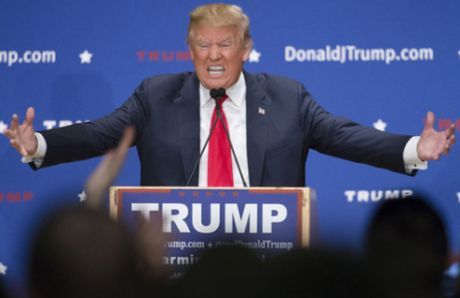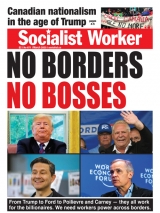Features
You are here
Is Trump fascist?

March 28, 2016
Is Donald Trump a fascist? This is a question I’ve heard quite frequently lately. As he continues to cruise towards the Republican nomination, many who once dismissed his campaign as a joke or rubbed their hands together in glee at the apparent collapse of the GOP are now feeling distinctly nervous.
Now that he stands a chance of winning the presidency it has become important to analyze the threat he represents to people in America and abroad. The desire to quantify the threat posed by Trump is at the heart of the debate over whether he is a fascist. Is Trump a new threat to the American working class, or is he just another reactionary puppet obeying the whims of capital?
Right-wing rhetoric
As Trump’s campaign moves from strength to strength, many American political commentators have started to sound the alarm. After establishment conservatives like John McCain and Mitt Romney, Trump looks pretty different. Many onlookers both abroad and in America have begun comparing Trump’s rhetoric to that of Benito Mussolini and Adolf Hitler. Trump has been called a fascist by everyone from comedian Louis CK to Eva Schloss, step-sister of Anne Frank.
This comparison is not surprising. Trump’s appeal to a mythical past in which America was Great and took shit from no-one sounds an awful lot like Mussolini’s appeal to the greatness of the Roman Empire. It is true that much of Donald Trump’s rhetoric resembles that of historical fascists, but is that resemblance more just than superficial?
In trying to decide whether Trump is a bonafide fascist, the first task is to decide what a fascist is. It is popular in liberal circles to define fascism purely based on its ideology and rhetoric. From this perspective, it is easy to conclude that Donald Trump is a real fascist. Trump, like Mussolini and Hitler, appeals to an idealized past, and promises a return to the former glory of the American Empire. Trump also leans heavily on nationalist rhetoric, though this is hardly unique for and American politician.
Striking, though, is the degree to which this nationalist rhetoric is a cover for dog whistle appeals to racism. In Trump’s usage, “American” is a synonym for white heterosexual conservative Christian. We’ve all heard Trump refer to Mexicans as rapists, suggest building border walls, and enthuse about the idea of registering Muslims.
But to define him as a fascist by matching his rhetoric to that of Hitler and Mussolini reveals a problem. If Trump is a fascist because he sells the fiction of national revitalization and demonizes anyone outside of an artificially constructed in-group, then so is every other Republican candidate.
Trump’s racist rhetoric is not unique in American politics. Nor is his in-your-face nationalism. Fascism cannot be identified by examining the rhetoric and ideology of political figures, because fascism has no consistent ideology.
Fascism
Most attempts to define fascism suffer from the Liberal idea that fascism is just an evil idea supported by violent people. But fascism is born not of idealism, but of ruthless pragmatism: fascism is capitalism in decay, a last ditch effort to preserve the privilege of the ruling class in the face of potential Proletarian revolution. When fascism has succeeded, it has done so by exploiting the despair of petty bourgeoisie in the face of economic crisis and redirecting it against the Proletariat at large.
The first role of Mussolini’s fascism was to crush the organs of worker power in Italy. Under his direction, fascist thugs spread out across the Italian countryside burning labour halls and beating pro-communist workers. Mussolini built street fighting organizations that burned socialist newspaper offices, intimidated striking labourers until they couldn’t field enough workers to mount a successful strike action, and beat and murdered socialists in the streets.
Trump’s rhetoric may be alarmingly similar to Mussolini’s, but the similarity is only skin deep. It is important that socialists remember just how dangerous real fascism is. Yes, Trump’s supporters have engaged in some violence against left protestors, and yes, Donald Trump has implicitly endorsed such violence, but that is a far cry from the organized, murderous street gangs whose truncheons and rifles have installed fascist governments. Trump’s rhetoric is dangerous, but not by itself.
As Leon Trotsky said in his 1932 essay What Next? Vital Questions for the German Proletariat, “At the moment that the ‘normal’ police and military resources of the bourgeois dictatorship, together with their parliamentary screens, no longer suffice to hold society in a state of equilibrium—the turn of the fascist regime arrives.”
In order for fascism to succeed, the conditions for its success must already exist. Italy’s capitalists turned to Fascism only reluctantly. In order for Mussolini to succeed, the Italian economy had to be in total disarray, the left had to be ascendant, and the existing mechanisms of the state had to be insufficient for the task of restraining revolutionary change.
Lessons from Berlusconi
A better Italian comparison to Trump is not Benito Mussolini but Silvio Berlusconi—the bigoted billionaire who some dismissed as a joke, but who became Italy’s longest-serving prime minister. Like Trump, Berlusoni used his wealth to broadcast his image as a popular figure challenging the status quo, playing on dissilusionment with the establishment and claiming to be a saviour to make the country great again. Like Trump, Berlusconi was a misogynist and a racist, including scapegoating the Roma population. While these bigoted billionairs encourage the rise of far-right groups, they have no fascist movements behind them.
If Trump were to be elected, he would govern just as his predecessors have: as a simple pawn of the capitalist class, through the traditional mechanisms available to an American President. This does not diminish concerns about Trump but provides a better framework to confront him.
If he wins the Republican nomination we are sure to face strong pressure from the Liberal left to support Hillary Clinton as the lesser of two evils. We must not fall into the trap of supporting one neoliberal against another, because we know that either Clinton or Trump would pursue a policy of total submission to capital. And support for Clinton could pave the way for Trump, as Berlusconi showed.
In the early 2000s there were huge mobilizations across Italy—including hundreds of thousands marching against the G8, millions marching against war a series of general strikes against Berlusconi. The left organization Rifondazione Communista had tens of thousands of members and played a key role in the mobilizations, but then subordinated the movements to supporting the centre-left government of Romano Prodi against Berlusconi. When Prodi continued neoliberal policies and war, the left collapsed and Berlusconi was re-elected.
The best challenge to Trump has been the movements for Black Lives Matter, $15 minimum wage, climate justice, Palestine solidarity and others, who came together to shut down Trump rallies—in actions that Clinton condemned as “violent” and “divisive.” If Sanders endorses Clinton and the movements follow him into the Democratic Party, Trump could emerge as the only anti-establishment candidate and win from the right.
Regardless who is elected to lead the twin parties of American capitalism, movements need to continue mobilizing through the election and beyond, challenging both Trump and the capitalist system that breeds him.
Join the conference Ideas for Real Change: Marxism 2016, including the sessions "Racism, the security state and C-51," "Refugees, racism and resistance," and "Why is capitalism in crisis?" Register today and join/share on facebook.
Section:










